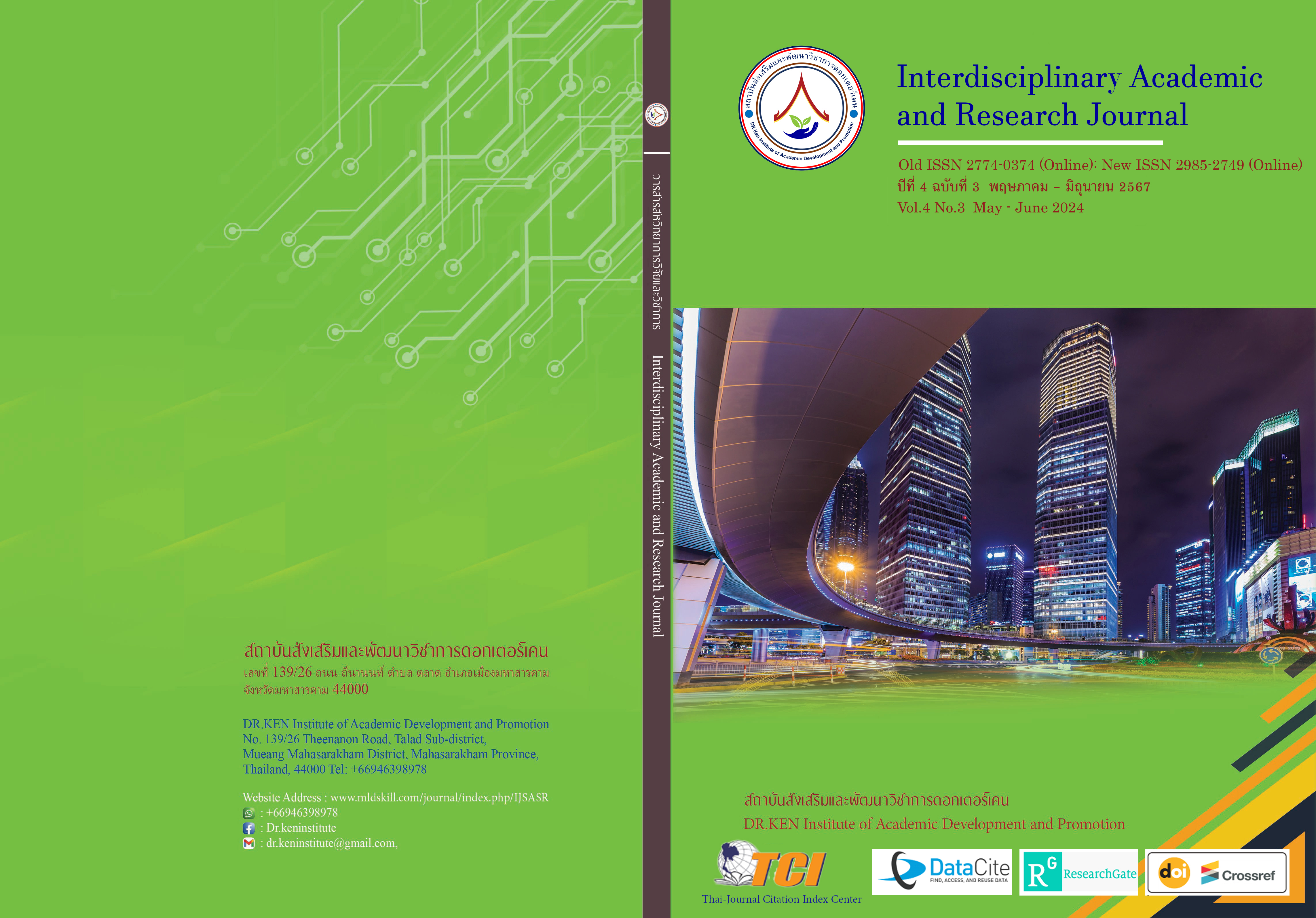Developing Problem-solving Abilities of Grade 3 Students by Organizing; Case Study Learning Activities
DOI:
https://doi.org/10.60027/iarj.2024.275958Keywords:
Problem Solving; , Learning Activities; , Case StudiesAbstract
Background and Aims: Using case studies to structure learning activities is a good technique to help students become more adept at addressing problems. Develop your capacity for critical thought as well as cooperation and communication. include the capacity to use information in practical situations. By structuring learning activities around case studies, the goal is to help third-year primary school pupils meet the required 75 percent proficiency in problem-solving.
Methodology: The intended audience for this study was There is one Grade 3 class in Ban Nong Saeng School in Yang Talat District, Kalasin Province, with a total of eleven pupils in semester 2, academic year 2021. Kalasin Primary Education Area 2's Educational Service Area Office by purposeful selection Perform two cycles of operational research. One of the research tools is a learning management system that makes use of case studies on students' enthusiasm. Grade 3: There are six plans totaling twelve hours, which are divided into five stages: preparation, proposal, case study, and analysis. phases of summary and assessment. (2) The problem-solving ability of third-grade primary school students was assessed using a 5-level estimation scale based on Weir's concept, with a total of 12 items. Four situations were used to assess the problem-solving ability of the students before the organization of learning activities, and after two operational cycles, each with 12 operations, the results showed a consistency value between 0.97, a discriminatory power value between 0.30-0.73, and a confidence value of 0.91. Content analysis and an examination of students' problem-solving skills following the arrangement of learning activities in each operational cycle are used in the data analysis for the qualitative research. Standard deviation, mean, and percentage are among the statistics used. The 75% passing criterion was established.
Results: Before being given the case study-based learning activities, 11 students' average problem-solving skill scores in each area fell short of the 75% required. Although all students demonstrated improved problem-solving skills in the first operational cycle, nine students' evaluation results overall failed to meet the 75% criterion. Additionally, it was discovered in the second operational cycle that every student met the requirements of 75% in every subject and could solve problems. When planning learning activities with case studies, educators should consider the skills of the students, the nature of the problems, and their comprehension of each stage. They should also continuously support and encourage students to voice their perspectives share ideas, and learn to know the group members.
Conclusion: The data shows that students' problem-solving abilities had a considerable initial deficit but had significantly improved with the introduction of case study-based learning. Nonetheless, regular support and customized methods are still necessary to guarantee that students consistently reach the necessary competency levels in all areas, highlighting the significance of continuing instruction and creating cooperative learning environments.
References
กระทรวงศึกษาธิการ. (2551). หลักสูตรแกนกลางการศึกษาขั้นพื้นฐาน พุทธศักราช 2551. กรุงเทพฯ: กระทรวงศึกษาธิการ.
เกษศิริ การะเกษ. (2553). การพัฒนาบทเรียนผ่านเครือข่ายคอมพิวเตอร์แบบเรียนรู้โดยใช้กรณีศึกษาที่มีต่อความสามารถในการแก้ปัญหา วิชาวิทยาศาสตร์ สำหรับนักเรียนระดับประถมศึกษาปีที่ 6. วิทยานิพนธปริญญาการศึกษามหาบัณฑิต: มหาวิทยาลัยเทคโนโลยีพระจอมเกล้าธนบุรี.
เชษฐ์ ศิริสวัสดิ์. (2556). การสอนให้คิดและสร้างสรรค์โครงงานวิทยาศาสตร์ด้วยการเรียนรู้เพื่อสร้างสรรค์ด้วยปัญญา. วารสารศึกษาศาสตร์ มหาวิทยาลัยบูรพา, 24(1), 1-15.
ดารกา วรรณวนิช. (2549). ยุทธศาสตร์การสอน. กรุงเทพฯ: โรงเรียนสาธิตมหาวิทยาลัย ศรีนครินทรวิโรฒประสานมิตร (ฝ่ายมัธยม).
ทิศนา แขมมณี. (2550). ศาสตร์การสอน: องค์ความรู้เพื่อการจัดการกระบวนการเรียนรู้ที่มีประสิทธิภาพใ พิมพ์ครั้งที่ 2. กรุงเทพฯ: จุฬาลงกรณ์มหาวิทยาลัย.
ทิศนา แขมมณี. (2551). 14 วิธีสอนสำหรับครูมืออาชีพ. กรุงเทพฯ: จุฬาลงกรณ์มหาวิทยาลัย.
นิตยา โสรีกุล. (2547). ผลการใช้การสอนแนะในการเรียนรู้ด้วยกรณีศึกษาบนเว็บที่มีต่อการแก้ปัญหาของนักเรียนชั้นมัธยมศึกษาปีที่ 1 ที่มีรูปแบบการคิดต่างกัน. วิทยานิพนธ์ปริญญาการศึกษามหาบัณฑิต: จุฬาลงกรณ์มหาวิทยาลัย.
ฤทัยวรรณ คงชาติ. (2557). การพัฒนาการคิดวิเคราะห์ของนักเรียนชั้นประถมศึกษาปีที่ 6 โดยใช้เทคนิคการจัดผังลายเส้น. กรุงเทพฯ: มหาวิทยาลัยศรีนครินทรวิโรฒ.
วัชรา เล่าเรียนดี. (2552). รูปแบบและกลยุทธ์การจัดการเรียนรู้เพื่อพัฒนาทักษะการคิด. พิมพ์ครั้งที่ 4. กรุงเทพฯ: มหาวิทยาลัยศิลปากร.
วัฒนาพร ระงับทุกข์. (2554). การจัดทำหลักสูตรสถานศึกษา: ตามหลักสูตรการศึกษาขั้นพื้นฐาน พ.ศ. 2551. กรุงเทพฯ: พริกหวานกราฟฟิค.
สมพงษ์ จิตระดับ. (2551). การสอนภาษาไทยในยุคโลกาภิวัตน์. กรุงเทพฯ: จุฬาลงกรณ์มหาวิทยาลัย.
สสวท. (2555). คู่มือการจัดการเรียนรู้วิทยาศาสตร์ตามแนวทาง STEM. กรุงเทพฯ: สถาบันส่งเสริมการสอนวิทยาศาสตร์และเทคโนโลยี.
สาคร สุขศรีวงศ์. (2554). การจัดการ: จากมุมมองนักบริหาร. กรุงเทพฯ: จี.พี. ไซเบอร์พรินท์.
สำนักงานคณะกรรมการการศึกษาแห่งชาติ. (2545). แนวทางการจัดการศึกษาตามหลักปรัชญาเศรษฐกิจพอเพียง. กรุงเทพฯ: สำนักงานคณะกรรมการการศึกษาแห่งชาติ.
สำนักทดสอบทางการศึกษาสำนักงานคณะกรรมการการศึกษาขั้นพื้นฐาน. (2561). รายงานผลการทดสอบทางการศึกษาระดับชาติขั้นพื้นฐาน (O-NET) ปีการศึกษา 2560. กรุงเทพฯ: สำนักทดสอบทางการศึกษาสำนักงานคณะกรรมการการศึกษาขั้นพื้นฐาน.
สุคนธ์ สินธพานนท์. (2551). นวัตกรรมการเรียนการสอนเพื่อพัฒนาคุณภาพของเยาวชน. กรุงเทพฯ: : ศูนย์หนังสือจุฬาลงกรณ์มหาวิทยาลัย.
สุวิชา วันสุดล. (2554). การศึกษาผลสัมฤทธิ์ทางการเรียนวิทยาศาสตรและความสามารถในการคิดแก้ปัญหาทางวิทยาศาสตร์ของนักเรียนชั้นมัธยมศึกษาปีที่ 1 ที่ไดรับการจัดการเรียนรู้โดยใช้เทคนิค การสอนแบบ 4 MAT และการจัดการเรียนรู้โดยใช้รูปแบบซิปปา. วิทยานิพนธ์ปริญญาการศึกษามหาบัณฑิต: มหาวิทยาลัยศรีนครินทรวิโรฒประสานมิตร.
สุวิทย์ มูลคำ. (2551). การสอนคิดวิเคราะห์. กรุงเทพฯ: จุฬาลงกรณ์มหาวิทยาลัย.
Clift, S., & Forrest, S. (1999). Gay Men and Tourism: Destinations and Holiday Motivations. Tourism Management, 20, 615-625. https://doi.org/10.1016/S0261-5177(99)00032-1 DOI: https://doi.org/10.1016/S0261-5177(99)00032-1
Gibson, E., Wardle, J., & Watts, C. (1998) Fruit and Vegetable Consumption, Nutritional Knowledge and Beliefs in Mothers and Children. Appetite, 31, 205-228.http://dx.doi.org/10.1006/appe.1998.0180 DOI: https://doi.org/10.1006/appe.1998.0180
Piaget, J. (1960). The Moral Judgment of the Child. Illinois: The Free Press.
Smith: L., & Ragan, T.J. (1999). Instructional Design. New York: John Wiley & Sons Inc.
Weir, J.J. (1974). Problem Solving Everybody's Problem. The Science Teacher, 4(2), 16-18.
Downloads
Published
How to Cite
Issue
Section
License
Copyright (c) 2024 Interdisciplinary Academic and Research Journal

This work is licensed under a Creative Commons Attribution-NonCommercial-NoDerivatives 4.0 International License.
Copyright on any article in the Interdisciplinary Academic and Research Journal is retained by the author(s) under the under the Creative Commons Attribution-NonCommercial-NoDerivatives 4.0 International License. Permission to use text, content, images, etc. of publication. Any user to read, download, copy, distribute, print, search, or link to the full texts of articles, crawl them for indexing, pass them as data to software, or use them for any other lawful purpose. But do not use it for commercial use or with the intent to benefit any business.
















.png)


